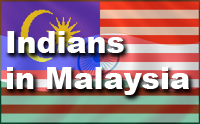
The third largest ethnic group in Malaysia after the Chinese and the Malays are the Malaysian Indians. Despite the fact that the Indians constitute about 8% of the country's population of 22 million they own less than 2% of its national wealth. According to The Economist (22nd Feb 2003), "they make up 14% of its juvenile delinquents, 20% of its wife and child beaters and 41% of its beggars.
They make up less than 5% of the successful university applicants." The story of the Indians has been a case of progressive deterioration from the time Malaysia became independent in 1957. The total population of Indians in Malaysia is 2,987,950 which is 9.35% of the total Population.
The mass Indian (South Indian) immigration can be traced back to the early 20th century when the Britishers brought them to meet the labor force requirements in the colonial public services and in private plantations. While the bulk of the Tamils were employed in the plantations, the Sri Lankan Tamils and Malayalees were in supervisory or clerical positions. Of the North Indians, the Punjabi's were in the police force, while the Gujaratis and Sindhis were in the business (mostly textiles). Despite the mass exodus of South Indians back to India after independence and after the racial riots of May 1969, the Tamils (South Indians) constitute about 80% of the total Indian community.
The Indians themselves are to some extent responsible for their present unenviable and ignominious status, and the policies of the Malaysian Government since independence had not been helpful either. Ignorance born out of poverty in the plantations resulted in many of them not getting citizenship which was offered in 1957 when Malaysia became independent. This prevented them from getting jobs.
A major setback for the Indian labor force was the steady closure of the rubber plantations giving way to tea and oil palm plantations. Their numbers started dwindling and they had competition from the illegal Indonesian immigrants. Unlike the Chinese who lay great emphasis on education, it was not given due importance by the Indian working class. The Tamil schools in the estates were often mere apologies and offered no opportunity for progress in higher education.
The undue importance on Tamil education has also weakened the Indian community in competing with the indigenous Malays and the Chinese. One of the major reasons for the low percentage of Indian origin students in the tertiary institutions in the country is the lack of merit and as a result, even the quotas set for the Indians remain unutilised.
Despite their economic backwardness, the Indians were a peace loving people and were not involved in any racial riots either in May 1969 or later except for a few incidents of clashes on account of religious sentiments. However in March 2001, the ethnic clashes between Indians and Malays in a village in the outskirts of Kuala Lumpur, brought into focus the plight of the Indian community in Malaysia. The incident has since been forgotten on the assumption that the clashes resulted on account of poor living conditions in the villages than the racial differences. There has been no introspection of this incident by the Government or by the Malaysian Indian Congress (MIC), the leading political party of the Indians.
The Malaysian Government policies since independence have also been consistently to the detriment of the non-Malays in general though the Indian community seems to be most hard hit. The first major step was the introduction of work permits for the non-citizens when a majority of Indian workers had not obtained Malaysian citizenship. Subsequently in 1971 with its New Economic Policy, the Government championed the cause of the Malays by the policy of "Bhumiputras"(sons of the soil). The Bhumiputras were to have a major share in the public sector while the private sector remained secure with the Chinese.
The introduction of quotas for the different races in the educational institutions has also adversely affected the Indian community. The New Development Plan for the period 1991-2000 was also designed to achieve the socio-economic upliftment of the Bhumiputras and the MIC's efforts to place the Indians in a separate ethnic grouping seems to have made no headway with the Malaysian Government. Being a minority, they do not have the numerical strength to exert any political influence nor do they make any significant contribution to the national economy. The ruling government's apathy to the Indians is therefore understandable.

